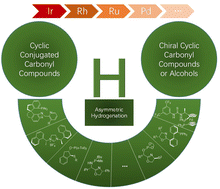Recent advances in the metal-catalyzed asymmetric alkene hydrogenation of cyclic conjugated carbonyl compounds
Abstract
The transition metal-catalyzed asymmetric hydrogenation of carbon–carbon double bonds is recognized as one of the most straightforward methods for the preparation of stereopure compounds. Chiral cyclic motifs have widespread applications in organic synthesis and can also be prepared via this strategy. This review summarizes the recent advances (2016–2023) in the stereoselective metal-catalyzed hydrogenation of cyclic α,β-unsaturated ketones, lactams and lactones since considerable developments in this regard were made. The applications of these methodologies in synthesis are also outlined where relevant.

- This article is part of the themed collections: 2024 Organic Chemistry Frontiers Review-type Articles and 2024 Organic Chemistry Frontiers HOT articles


 Please wait while we load your content...
Please wait while we load your content...